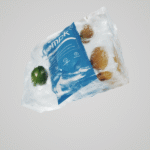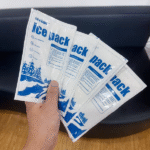Voyager avec des articles périssables nécessite une planification, Et la glace sèche offre un moyen sûr de garder les articles figés pendant les vols. La réponse courte est oui; Vous pouvez apporter de la glace sèche dans un avion. Cependant, Il existe des réglementations strictes pour assurer la sécurité. Ce guide explore les règles de transport de la glace sèche dans 2025, y compris l'emballage, étiquetage, Et les dernières tendances pour rendre votre voyage plus lisse et plus sûr.
-
Règles de poids et d'étiquetage de la glace sèche: Renseignez-vous sur le 2.5 limite de kg, Étiquetage approprié, et directives d'emballage.
-
Emballage de la glace sèche pour les voyages en avion en toute sécurité: Conseils étape par étape sur la façon d'emballer efficacement votre glace sèche.
-
Erreurs courantes pour éviter: Découvrez les erreurs courantes qui pourraient faire en sorte que votre glace sèche soit confisquée.
-
Alternatives à la glace sèche: Explorez d'autres options de refroidissement comme des packs de gel et des matériaux de changement de phase.
-
2025 Innovations dans les voyages à la chaîne du froid: Comprendre les dernières tendances de la technologie des voyages en avion et du rythme du rythme.
Pourquoi la glace sèche est-elle si populaire pour les voyages en avion?
Glace sèche, ou dioxyde de carbone solide, has a sublimation point of -109°F (-78.5°C), making it an ideal solution for keeping items frozen without creating a mess. Contrairement à la glace ordinaire, it doesn’t leave liquid residue, and it keeps things frozen much longer. Cependant, the extreme cold and the gas it releases can pose certain risks, which is why its transport on planes is regulated by the FAA and TSA.
Risks Associated with Dry Ice
-
Suffocation Hazard: La glace sèche sublimait le dioxyde de carbone, qui peut déplacer l'oxygène, leading to dizziness, unconsciousness, or even suffocation in confined spaces if not vented properly.
-
Overpressurization: If dry ice is sealed in an airtight container, the gas expansion could cause the container to rupture violently.
-
Frostbite/Burns: Dry ice can cause severe burns if it comes into direct contact with skin, requiring protective gloves when handling.
How Much Dry Ice Can You Bring on a Plane?
Dans 2025, the TSA and FAA allow passengers to carry up to 5.5 livres (2.5 kg) of dry ice in both carry-on and checked luggage, as long as the packaging allows gas to escape. Exceeding the 2.5 kg limit means the dry ice must be shipped as cargo, subject to stricter regulations.
Dry Ice in Carry-On vs. Bagages enregistrés
Both carry-on and checked baggage are permissible for transporting dry ice. Cependant, you need to ensure the container is vented and labeled according to regulations.
| Type de bagages | Poids maximal | Packaging Requirements | Key Action |
|---|---|---|---|
| Carry-On | 2.5 kg (5.5 lbs) | Ventilé, étiqueté “Glace sèche” | Declare at check-in |
| À carreaux | 2.5 kg (5.5 lbs) | Ventilé, étiqueté “Glace sèche” | Declare at check-in |
| Cargaison | Varie | Must meet IATA requirements | Special approval |
Why Ventilation is Crucial
Sans ventilation adéquate, the carbon dioxide gas released by the dry ice can build up pressure inside the container, potentially causing it to rupture. Always use a container with vents or loosable lids to allow the gas to escape. Some containers, such as soft coolers or styrofoam boxes, may not meet the required safety standards due to their inability to vent effectively.
How to Pack Dry Ice for Safe Air Travel
Packing dry ice properly is essential to ensure both safety and compliance with regulations.
Step-by-Step Packing Tips:
-
Choisissez le bon conteneur: Use a hardside cooler or insulated box that has vents. Avoid airtight containers like styrofoam coolers.
-
Pre-Chill the Container: This helps reduce the sublimation rate of dry ice, keeping it colder for longer.
-
Wrap and Position the Dry Ice: Wrap the dry ice in paper or cloth to protect your hands and help slow the sublimation process. Place it on top of your perishable items, Alors que l'air froid coule.
-
Leave Space for Gas Venting: Never pack the container too full. Leave some airspace for proper ventilation.
-
Étiquetez le colis: Clearly label the container with “Dry Ice” or “Carbon Dioxide, Solid” and include the net weight.
Packing Material Comparison
| Material/Container | Venting Capability | Cold Tolerance | Suitability for Air Travel |
|---|---|---|---|
| Rotomolded Mini Cooler | Excellent (screw-crack lid) | Excellent (-109°F) | Best option for long holds |
| High-Density Polyethylene Mailer Box | Bien (pre-drilled ports) | Bien (parcours courts) | Suitable for smaller shipments |
| Smart PCM Cooler | Excellent (automatic valve) | Bien (adjustable range) | Long hold time with monitoring |
| Soft Fabric Cooler Bag | Limité (may trap gas) | Poor (may crack) | Avoid for dry ice transport |
2025 Trends in Dry Ice Transportation
Innovations dans les voyages à la chaîne du froid:
À mesure que l'industrie de la chaîne du froid évolue, new trends in packaging and transportation are emerging, y compris:
-
Capteurs intelligents: Devices that monitor temperature, humidité, and gas release in real-time, ensuring better management during transit.
-
Blockchain Technology: Enhancing transparency in the tracking of dry ice shipments for better quality control and dispute resolution.
-
Emballage respectueux de l'environnement: The shift towards sustainable materials, such as biodegradable coolers and packaging, reduces environmental impact.
Ce que cela signifie pour vous:
These trends suggest that air travel with dry ice will become safer, plus efficace, and more environmentally friendly, thanks to innovations in logistics technology and packaging solutions.
FAQ: Common Questions About Dry Ice in Air Travel
Q: Can I bring dry ice in my carry-on bag?
Oui, you can bring up to 2.5 kg (5.5 lbs) of dry ice in your carry-on bag, provided the container vents and is clearly labeled.
Q: What happens if I don’t get airline approval?
Without airline approval, you risk your dry ice being confiscated at the security checkpoint, ou pire, being delayed or fined.
Q: Comment puis-je me débarrasser des restes de neige carbonique?
Always allow dry ice to sublimate in a well-ventilated outdoor area. Never dispose of it in sinks or toilets as the extreme cold can damage plumbing.
Conclusion et recommandations
Traveling with dry ice is possible, but it requires careful planning to avoid safety hazards and comply with regulations. Ensure your container is properly vented, étiqueté, and that you inform the airline in advance. With these simple steps, you can enjoy a smooth flight without any issues related to transporting dry ice.
Conseils exploitables:
-
Plan Ahead: Always contact your airline before departure to confirm specific dry ice regulations.
-
Pack Carefully: Use a vented, insulated container and wrap the dry ice appropriately.
-
Restez informé: Keep up-to-date with the latest regulations and trends in air travel with dry ice.
À propos du tempk
Et tempk, we specialize in providing innovative cold chain solutions that ensure the safe transport of temperature-sensitive goods. From advanced insulation to temperature monitoring systems, we help you maintain the correct conditions during your journey.
For more information or to explore our product range, visite Rotation.
























